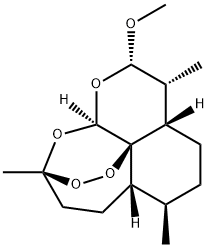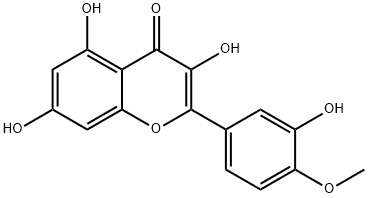Quercetin , 95% , 117-39-5
Synonym(s):
Quercetin dihydrate;Quercetin hydrate;2-(3,4-Dihydroxyphenyl)-3,5,7-trihydroxy-4H-1-benzopyran-4-one;3,3′,4′,5,6-Pentahydroxyflavone;3,3′,4′,5,7-Pentahydroxyflavone dihydrate
CAS NO.:117-39-5
Empirical Formula: C15H10O7
Molecular Weight: 302.24
MDL number: MFCD00006828
EINECS: 204-187-1
| Pack Size | Price | Stock | Quantity |
| 1g | RMB31.20 | In Stock |
|
| 10G | RMB63.20 | In Stock |
|
| 50G | RMB159.20 | In Stock |
|
| 250G | RMB639.20 | In Stock |
|
| others | Enquire |
PRODUCT Properties
| Melting point: | 316.5 °C |
| Boiling point: | 363.28°C (rough estimate) |
| Density | 1.3616 (rough estimate) |
| refractive index | 1.4790 (estimate) |
| storage temp. | room temp |
| solubility | insoluble in H2O; ≥15.1 mg/mL in DMSO; ≥3.28 mg/mL in EtOH |
| form | solid |
| pka | 6.31±0.40(Predicted) |
| color | Yellowish |
| biological source | synthetic (organic) |
| Water Solubility | <0.1 g/100 mL at 21 ºC |
| Merck | 13,8122 |
| BRN | 317313 |
| InChIKey | REFJWTPEDVJJIY-UHFFFAOYSA-N |
| LogP | 1.989 (est) |
| CAS DataBase Reference | 117-39-5(CAS DataBase Reference) |
| IARC | 3 (Vol. Sup 7, 73) 1999 |
| EPA Substance Registry System | Quercetin (117-39-5) |
Description and Uses
The name of quercetin has been used since 1857, which is derived from quercetum
(oak forest) after Quercus. Quercetin is widely found in flowers, leaves, and
fruits of various plants. Vegetables (such as onions, ginger, celery, etc.), fruits (such
as apples, strawberries, etc.), beverages (such as tea, coffee, red wine, fruit juice,
etc.), and more than 100 kinds of Chinese herbal medicines (such as Threevein
Aster, mountain white chrysanthemum, Huai rice, Apocynum, Ginkgo biloba, etc.)
contain this ingredient.
Threevein Aster is a Chinese herbal medicine and used in Jiangxi province,
China, for more than 30 years. Its plant name is three veins Mala, Compositae. It is
rich in drug sources, which can be found in Southern provinces of China. Clinical
practice proved that it has significant anti-inflammatory and expectorant effects, and
it is a good prescription for the treatment of elderly chronic bronchitis.
- Quercetin has been used as an antioxidant which reversed the immunosuppressive effects of high glucose and hyperglycemic sera in type 2 diabetic patients.
- It has been used as a detoxifying phytochemical in Apis mellifera.
- It has been used as a positive control in DPPH (2,2- diphenyl-1-picryhydrazyl) radical scavenging assay. It has also been used for the preparation of calibration curve to determine total flavonoid content.
Safety
| Symbol(GHS) |  GHS06 |
| Signal word | Danger |
| Hazard statements | H301 |
| Precautionary statements | P264-P270-P301+P310-P405-P501 |
| Hazard Codes | T,Xi |
| Risk Statements | 25-36/37/38 |
| Safety Statements | 45-36-26 |
| RIDADR | 2811 |
| WGK Germany | 3 |
| RTECS | LK8750000 |
| HazardClass | 6.1(b) |
| PackingGroup | III |
| HS Code | 29329990 |
| Hazardous Substances Data | 117-39-5(Hazardous Substances Data) |
| Toxicity | LD50 oral in rat: 161mg/kg |





